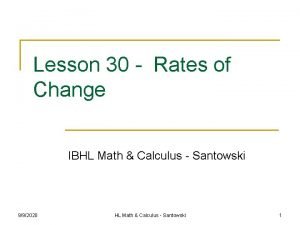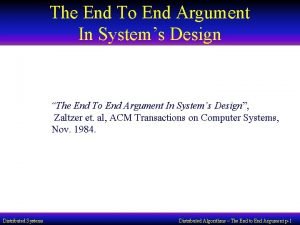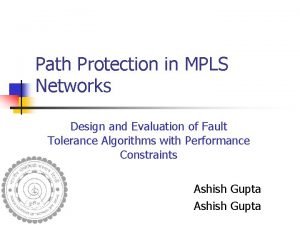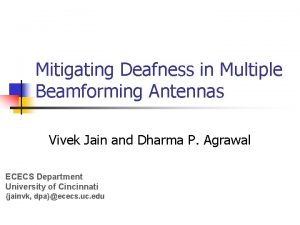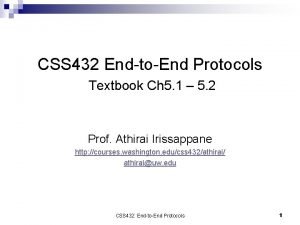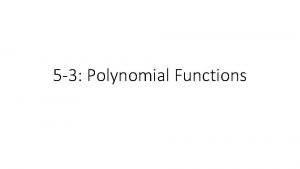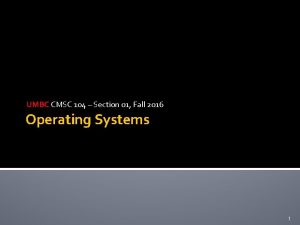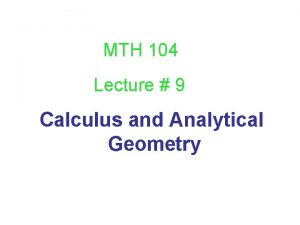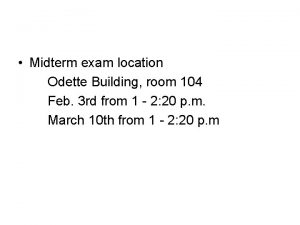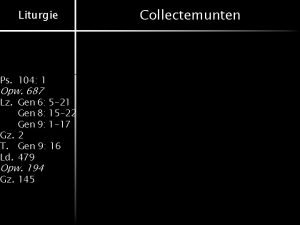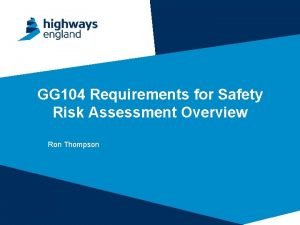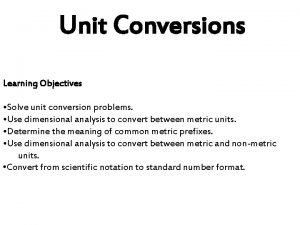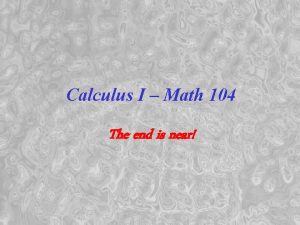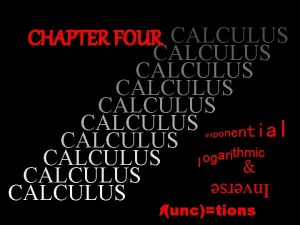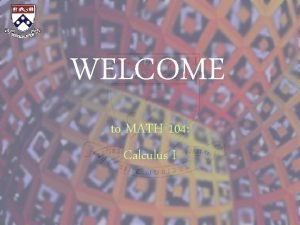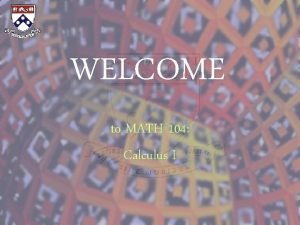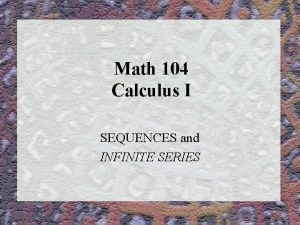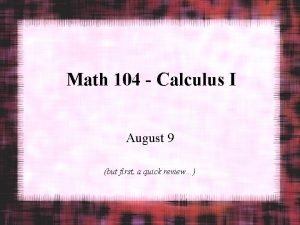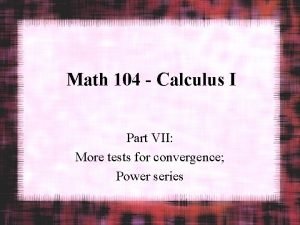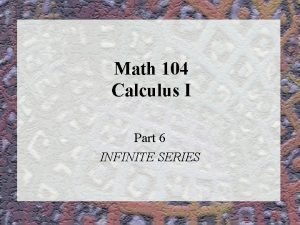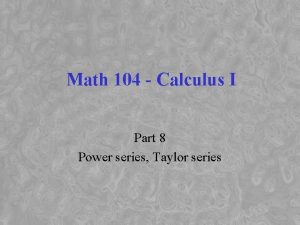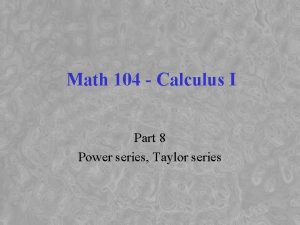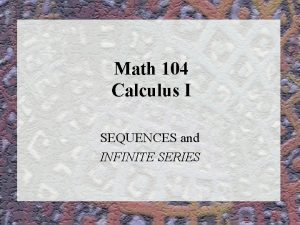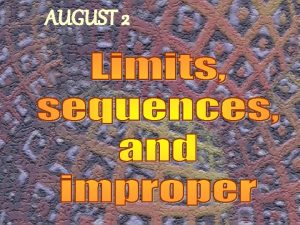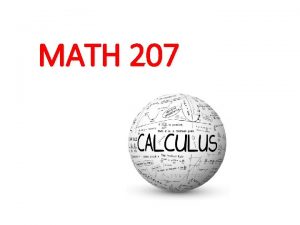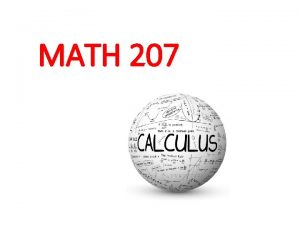Calculus I Math 104 The end is near




































- Slides: 36

Calculus I – Math 104 The end is near!

Application of Series 1. Limits: Series give a good idea of the behavior of functions in the neighborhood of 0: We know for other reasons that We could do this by series:

This can be used on complicated limits. . . Calculate the limit: A. B. C. D. E. 0 1/6 1 1/12 does not exist

Application of series (continued) 2. Approximate evaluation of integrals: Many integrals that cannot be evaluated in closed form (i. e. , for which no elementary anti-derivative exists) can be approximated using series (and we can even estimate how far off the approximations are). Example: Calculate to the nearest 0. 001.

We begin by. . .

According to Maple. . . The last series is an alternating series with decreasing terms. We need to find the first one that is less than 0. 0005 to ensure that the error will be less than 0. 001. According to Maple: evalf(1/(7*factorial(3))), evalf(1/(9*factorial(4))), evalf( 1/(11*factorial(5))); . 02380952381, . 004629629630, . 000757576 evalf(1/(13*factorial(6))); . 0001068376068

Keep going. . . So it's enough to go out to the 5! term. We do this as follows: Sum((-1)^n/((2*n+1)*factorial(n)), n=0. . 5) = sum((-1)^n/((2*n+1) *factorial(n)), n=0. . 5); evalf(%); . 7467291967=. 7467291967

and finally. . . So we get that nearest thousandth. to the Again, according to Maple, the actual answer (to 10 places) is evalf(int(exp(-x^2), x=0. . 1)); . 74669241330

Try this. . . Sum the first four nonzero terms to approximate A. 0. 7635 B. 0. 5637 C. 0. 3567 D. 0. 6357 E. 0. 6735

Series approximations for functions, integrals etc. . We've been associating series with functions and using them to evaluate limits, integrals and such. We have not thought too much about how good the approximations are. For serious applications, it is important to do that.

Questions you can ask-1. If I use only the first three terms of the series, how big is the error? 2. How many terms do I need to get the error smaller than 0. 0001?

To get error estimates: Use a generalization of the Mean Value Theorem for derivatives

Derivative MVT approach:

If you know. . . If you know that the absolute value of the derivative is always less than M, then you know that | f(x) - f(0) | < M |x| The derivative form of the error estimate for series is a generalization of this.

Lagrange's form of the remainder:

Lagrange. . . Lagrange's form of the remainder looks a lot like what would be the next term of the series, except the n+1 st derivative is evaluated at an unknown point between 0 and x, rather than at 0: So if we know bounds on the n+1 st derivative of f, we can bound the error in the approximation.

Example: The series for sin(x) was:

5 th derivative For f(x) = sin(x), the fifth derivative is f '''''(x) = cos(x). And we know that |cos(t)| < 1 for all t between 0 and x. We can conclude from this that: So for instance, we can conclude that the approximation sin(1) = 1 - 1/6 = 5/6 is accurate to within 1/5! = 1/120 -- i. e. , to two decimal places.

Your turn. . .

Another application. . . Another application of Lagrange's form of the remainder is to prove that the series of a function actually converges to the function. For example, for the series for sin(x), we have (since all the derivatives of sin(x) are always less than or equal to 1 in absolute value):

Shifting the origin -Taylor vs Maclaurin So far, we've been writing all of our series as infinite polynomials and using values of the function f(x) and its derivatives evaluated at x=0. It is possible to change one's point of view and use values of the function and derivatives at other points.

As an example, we’ll return to the geometric series

Taylor series By taking derivatives of the function g(x) = -1/x and evaluating them at x=-1, we will discover that the expansion of g(x) we have found is the Taylor series for g(x) expanded around -1: g(x) = g(-1) + g '(-1) (x+1) + g ''(-1) +. .

Note:

Maclaurin Series expansions around points other than zero are useful when trying to approximate function values for x far from zero, but close to a different point where much is known about the function. But note that by defining a new function g(x) = f(x+a), you can use Maclaurin expansions for g instead of general Taylor expansions for f.

Binomial series

If p is not a positive integer. . .

Fibonacci numbers Everyone is probably familiar with the famous sequence of Fibonacci numbers. The idea is that you start with 1 (pair of) rabbit(s) the zeroth month. The first month you still have 1 pair. But then in the second month you have 1+1 = 2 pairs, the third you have 1 + 2 = 3 pairs, the fourth, 2 + 3 = 5 pairs, etc. . . The pattern is that if you have an pairs in the nth month, and an+1 pairs in the n+1 st month, then you will have a n + a n+1 pairs in the n+2 nd month. The first several terms of the sequence are thus: 1, 1, 2, 3, 5, 8, 13, 21, 34, 55, etc. . . Is there a general formula for a n ?

Generating functions This is a common problem in many parts of mathematics and science. And a powerful method for solving such problems involves series -- which in this case are called generating functions for their sequences. For the Fibonacci numbers, we will simply define a function f(x) via the series:

Recurrence relation To do this, we'll use the fact that multiplication by x "shifts" the series for f(x) as follows: Now, subtract the second two from the first -almost everything will cancel because of the recurrence relation!

The result is. . .

Further. . .

Then use partial fractions to write:

Work it out. . . First And

Now, recall that. . .

Our series for f(x) becomes:
 Seahawks tackling drills
Seahawks tackling drills Flipped math calculus
Flipped math calculus Math calculus
Math calculus Near end crosstalk
Near end crosstalk Near end crosstalk
Near end crosstalk Stroke volume units
Stroke volume units Factors affecting stroke volume
Factors affecting stroke volume Explain compiler construction tools
Explain compiler construction tools Front end and back end of compiler
Front end and back end of compiler Descendorektostomie definition
Descendorektostomie definition Yichao zhou
Yichao zhou End to end argument in system design
End to end argument in system design End to end accounting life cycle tasks
End to end accounting life cycle tasks End to end delay
End to end delay End to end delay
End to end delay End to end
End to end Comet knowledge graph
Comet knowledge graph Multiple procurement cycles
Multiple procurement cycles Even degree polynomial function
Even degree polynomial function Continuity and end behavior
Continuity and end behavior Cmsc 104 umbc
Cmsc 104 umbc Programa presupuestal 104
Programa presupuestal 104 Lativ104
Lativ104 Mth104
Mth104 Odette
Odette Mcb 104
Mcb 104 Psalm 104
Psalm 104 Gg 104
Gg 104 Cct 104
Cct 104 Aphorism 83 to 104
Aphorism 83 to 104 Cao 104
Cao 104 Cao 104 voorbeelden
Cao 104 voorbeelden Its 104 days of summer vacation lyrics
Its 104 days of summer vacation lyrics Csci 104
Csci 104 How to solve conversion problems
How to solve conversion problems I 102 104
I 102 104 Daily 10/4 keller williams
Daily 10/4 keller williams


